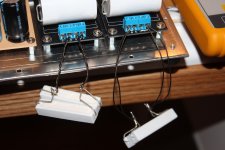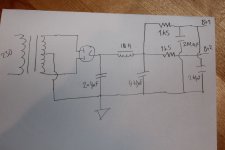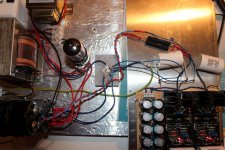I've got this crap to measure HV
And some pix on ripple out. First with noice unfiltered, second with a 10 kHz lowpass filtering
That's an active differential "probe". Its for having CMRR. Doesn't the PicoScope accept a normal single ended coaxial probe also?
From Pico website:
Our active differential probes let you use a conventional earthed oscilloscope to measure signals that are not referenced to ground, including mains voltages. They can also be used to measure and observe the waveforms of three–phase supplies or the gate and control signals of semiconductor circuits. They are ideal for investigating motor speed controls, uninterruptible power supplies, switch mode power supplies and process controllers.
"not referenced to ground"
Our active differential probes let you use a conventional earthed oscilloscope to measure signals that are not referenced to ground, including mains voltages. They can also be used to measure and observe the waveforms of three–phase supplies or the gate and control signals of semiconductor circuits. They are ideal for investigating motor speed controls, uninterruptible power supplies, switch mode power supplies and process controllers.
"not referenced to ground"
Before I contemplate over what you just say I did some DMM measures below.Can it read HZ at mV level? Press the frequency button for input and output probing.
Its suspiciously same level for in and out now, it could all be riding on the ground loop. Dress the long output cables in twisted pairs. Force pair, sense pair. Remeasure. Null the sense pair by jumpers at F0,S0 F+,S+. Remeasure.
Left shorted (damn unpealable old Ericsson phone cabling
 ) and twisted, right jumpered.
) and twisted, right jumpered.75 mV left and 76 right with DMM
Attachments
That's an active differential "probe". Its for having CMRR. Doesn't the PicoScope accept a normal single ended coaxial probe also?
How high a voltage AC/DC can a direct Pico input accept safely?
Input ranges ±10 mV, ±20 mV, ±50 mV, ±100 mV, ±200 mV, ±500 mV, ±1 V, ±2 V, ±5 V, ±10 V, ±20 V
DC accuracy (% of full scale) ±0.25% (±0.5% on ±50 mV range , ±1% on ±20 mV rangeI have normal probes 1x and 10x, maybe I should get others? The Diff probe makes hell of a noice by itself.
From Pico website:
Our active differential probes let you use a conventional earthed oscilloscope to measure signals that are not referenced to ground, including mains voltages. They can also be used to measure and observe the waveforms of three–phase supplies or the gate and control signals of semiconductor circuits. They are ideal for investigating motor speed controls, uninterruptible power supplies, switch mode power supplies and process controllers.
"not referenced to ground"
Im putting a clip to earthground when I use it.
Input ranges ±10 mV, ±20 mV, ±50 mV, ±100 mV, ±200 mV, ±500 mV, ±1 V, ±2 V, ±5 V, ±10 V, ±20 VDC accuracy (% of full scale) ±0.25% (±0.5% on ±50 mV range , ±1% on ±20 mV range
I have normal probes 1x and 10x, maybe I should get others? The Diff probe makes hell of a noice by itself.
Beyond the ranges of the Pico you quote there should be some max voltage input spec printed right on the scope box next to its input BNC. That should be respected in all occasions. A x10 or x100 probe cuts the input voltage by its dividing ratio. One danger is you accidentally throw the switch to x1 when on HV and bye bye Pico, another danger not common in what you do is you try measure some high amplitude very high frequency signal that the probe can not stand. Because they lose voltage spec progressively with frequency. They can be 300V up to 30kHZ, 100V by 1MHZ, 40V by 10MHZ and keep on falling for instance. There are fixed ratio probes without switches that are better optimized also. Keep in mind when you use X10 you lose 20dB SNR for measuring noise, 40dB for X100.
Beyond the ranges of the Pico you quote there should be some max voltage input spec printed right on the scope box next to its input BNC. That should be respected in all occasions. A x10 or x100 probe cuts the input voltage by its dividing ratio. One danger is you accidentally throw the switch to x1 when on HV and bye bye Pico, another danger not common in what you do is you try measure some high amplitude very high frequency signal that the probe can not stand. Because they lose voltage spec progressively with frequency. They can be 300V up to 30kHZ, 100V by 1MHZ and 40V by 10MHZ and falling for instance. There are fixed ratio probes without switches that are better optimized also. Keep in mind when you use X10 you lose 20dB SNR for measuring, 40dB for X100.
It says max 20 V on the Pico by the BNCs. Should I get some passive high attenuation probes (besides a new scope
 )
)Before I contemplate over what you just say I did some DMM measures below.
Left shorted (damn unpealable old Ericsson phone cabling) and twisted, right jumpered.
75 mV left and 76 right with DMM
The cables are much shorter than I thought from the first photos, but keep them twisted in any application short or long to load. They are not the problem it proved. One check less.
The strange thing is that I had almost the same figures yesterday with a completely other PSU. Im beginning to untrust my measures.
How does it heat up the diode valve and how is wired for that? Why B+2 has no output cap? Why I saw a star like GND node in one of your pics and I see just a serial return wiring in your diagram?
It says max 20 V on the Pico by the BNCs. Should I get some passive high attenuation probes (besides a new scope)
Not practical for tubes, get rid of it. Excellent for Arduino guys etc. Its nice it has many PC menus for analysis but not for you IMHO. Only the diff probe cost I saw could fetch you a workhorse American/German/Dutch old CRO in good working order. And there are refurbs serviced and calibrated also if you sell the whole Pico package to pony up for. Intensity graded DSO with good looking near CRO signal fidelity will set you back near $1000 bottom category and are full of functions you may find steep to comprehend. There are some analog Oriental scopes in production still. If I would look for Ebay vintage, that would be 24xx Tek, 465 Tek, Sencore SC3100, 60MHz+ Hameg, 50MHZ+ Philips etc. with many pictures of working screens and/or some return policy.
What data should I look for regarding scopes for my cup of tea?
I rewired a bit on the ground scheme. I had put a choke on the gnd rail b4 also, just to see if I had problems there. Now I got rid of it and every single gnd line is on the same star now. Same measures.
I rewired a bit on the ground scheme. I had put a choke on the gnd rail b4 also, just to see if I had problems there. Now I got rid of it and every single gnd line is on the same star now. Same measures.
Attachments
How does it heat up the diode valve and how is wired for that? Why B+2 has no output cap? Why I saw a star like GND node in one of your pics and I see just a serial return wiring in your diagram?
Its dual diode, 5AR4, new tranny has 5 V winding, yestedays had 4, thats why I used AZ1. I miss-drawed the schema, ofc both outputs has one 200 uF each.
What data should I look for regarding scopes for my cup of tea?
300V RMS or more CAT I input spec direct. 2 channels will be enough. 100MHZ if you can. Some will argue its too much for audio but I have seen edge ringing on audio equipment being muted enough on my 20MHZ Hameg CRO that I could see much better at 50MHZ+ on my DSOs.
I don't trust the measurements for now bcs there are many vague parameters. Just two simple questions: 1. Is there audible hum/buzz? 2. Is there instability on B+ lines DC values?
1. I have no audio circuit plugged in, just resistors so, no hum
2. Wandering maybe 0,2-0,3 V slowly (on 320 VDC). My experience is thats pretty normal. Or?
Wandering is excellent in %. Stable. Your rectifier valve heater wiring is floating as it should, right?
Yep. Or well, internally connected as you know
http://www.r-type.org/pdfs/gz34.pdf
- Home
- Amplifiers
- Tubes / Valves
- 6V6 line preamp


